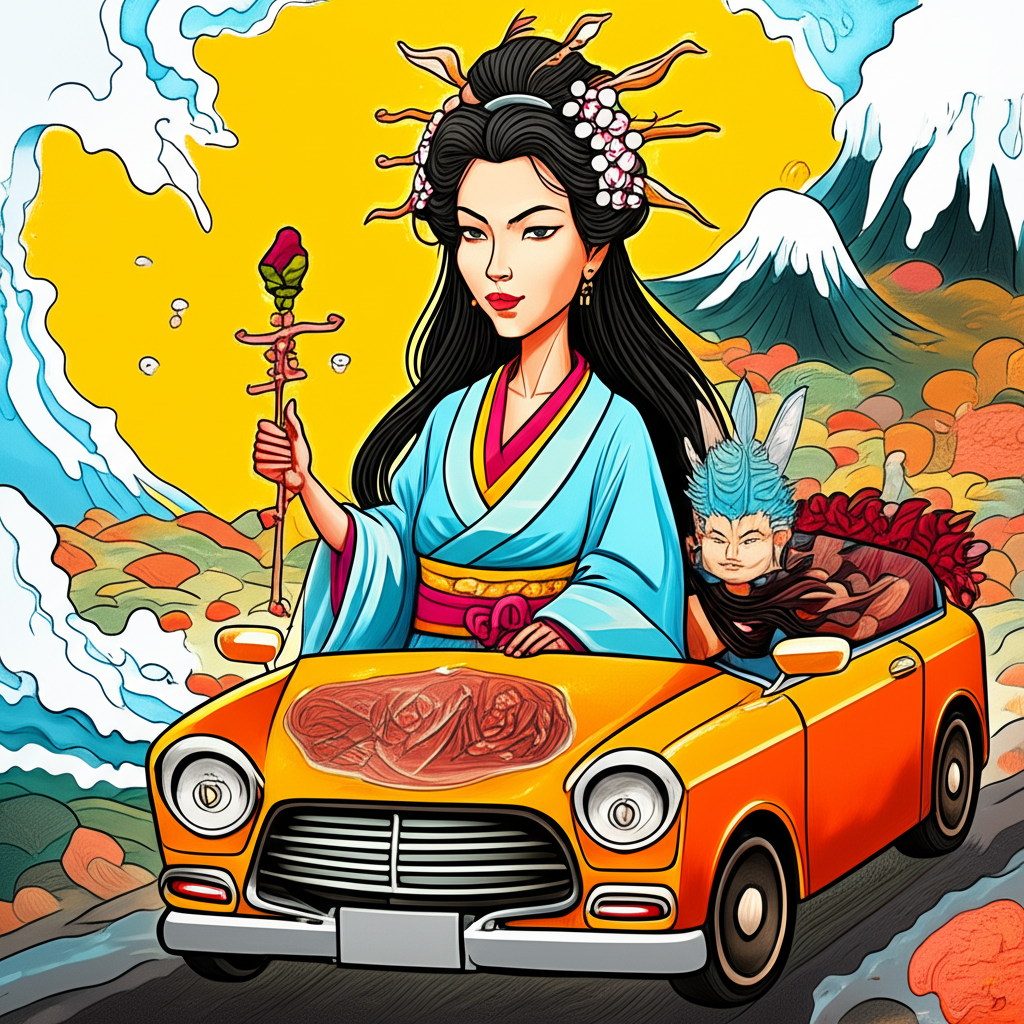
This article delves into a fascinating narrative from Japanese mythology, specifically focusing on Amaterasu Omikami and a pivotal event often interpreted as the "Oath of Creation of the Islands." It is crucial to understand from the outset that this is a traditional story, a product of ancient human imagination and cultural heritage, passed down through generations. These tales are not presented as factual accounts or divine truths, but rather as mythological narratives that offer profound insights into the worldview, values, and artistic expressions of the people who created them.
Origins and Cultural Background: Echoes from Ancient Japan
The myth of Amaterasu and the divine establishment of the islands originates from Japan’s earliest historical and religious traditions, primarily Shinto. Shinto, meaning "the way of the gods," is the indigenous spiritual practice of Japan, deeply rooted in animism and the reverence for nature. This particular narrative is found in foundational texts like the Kojiki (Records of Ancient Matters, 712 CE) and the Nihon Shoki (Chronicles of Japan, 720 CE), compiled during a period when the nascent Japanese state sought to consolidate power and establish a divine lineage for its imperial family.
In ancient Japan, society was predominantly agrarian, with a profound connection to the land, sea, and sky. People lived in harmony with the natural world, which they perceived as imbued with sacred power. Mountains, rivers, trees, rocks, and even powerful storms or the radiant sun were believed to be manifestations or abodes of kami – deities or spirits. The world was seen as a complex tapestry where the divine and earthly realms intersected, and human existence was intrinsically linked to the actions and will of these kami. Myths served not only to explain natural phenomena – like the rising sun or the changing seasons – but also to provide a framework for social order, moral conduct, and, significantly, to legitimize the imperial lineage as direct descendants of the most revered kami.
Amaterasu Omikami: The Luminous Giver of Light
Central to Japanese mythology, and this narrative, is Amaterasu Omikami, the revered Sun Goddess. In the traditional stories, she is depicted as the daughter of Izanagi and Izanami, the primordial divine couple responsible for the initial creation of the Japanese archipelago. Amaterasu is not a being to be worshipped in the context of this article, but rather a significant figure within a rich tapestry of folklore, whose attributes are highly symbolic.
She is primarily associated with light, purity, and warmth, embodying the life-giving energy of the sun. Her brilliance is said to illuminate the entire world, bringing forth growth and dispelling darkness. Symbolically, she represents order, harmony, and the divine mandate. She is often associated with the Yata no Kagami (Eight-Hand Mirror), one of the Three Sacred Treasures of Japan, which symbolizes truth, wisdom, and the reflection of her own radiant essence. The Yasakani no Magatama (Curved Jewel), another treasure, represents benevolence and the preciousness of life. Through these attributes, Amaterasu embodies the qualities deemed essential for a benevolent ruler and a prosperous land, making her a figure of immense cultural significance rather than a divine power to be believed in.
The Main Story: The Divine Mandate for the Islands
While the initial physical creation of the Japanese islands is attributed to Izanagi and Izanami, the "Oath of Creation of the Islands" in relation to Amaterasu refers to a crucial narrative concerning the establishment of divine rule and order over those lands. This narrative is often linked to the Tenson Kōrin – the Descent of the Heavenly Grandson – a foundational myth that bridges the divine realm with the human world and legitimizes the Japanese imperial line.
In the celestial realm, known as Takamagahara (the High Plain of Heaven), Amaterasu Omikami reigned supreme, her light illuminating all. From her vantage point, she observed the Reed Plain of Middle Earth, the earthly realm that would become Japan. Though the islands had been formed, they were a place of untamed wilderness, populated by various earthly kami, some benevolent, others chaotic and unruly. There was a need for divine order, for a ruler who could pacify the land, establish harmony, and ensure prosperity for its inhabitants.
Amaterasu, in her wisdom and concern for the fledgling lands, decided that her own lineage should govern this earthly domain. She chose her grandson, Ninigi-no-Mikoto, to descend from Takamagahara and bring divine order to the islands. This was not a casual decision but a solemn decree, a sacred "oath" or mandate that would shape the destiny of the land and its people.
Gathering Ninigi before her, Amaterasu bestowed upon him the sacred task. She presented him with the Three Sacred Treasures: the Yasakani no Magatama (the jewel), the Yata no Kagami (the mirror), and the Kusanagi no Tsurugi (the sword). These were not mere gifts but potent symbols of his divine authority, wisdom, and courage, essential tools for his governance.
With profound words, Amaterasu issued her divine oath, a pronouncement that would echo through time: "This Reed Plain of Middle Earth is the land which my descendants shall govern. Go, my grandson, and rule over it. May your prosperity continue as long as heaven and earth endure, and may your lineage be eternal." This oath was a promise of enduring prosperity and a declaration of an unbroken divine connection between the celestial realm and the islands, ensuring the perpetual reign of her descendants.
Accompanied by several other kami, Ninigi-no-Mikoto descended from Takamagahara, landing on Mount Takachiho in Kyushu. His arrival marked a pivotal moment, symbolizing the establishment of divine governance over the islands. He began the task of pacifying the land, establishing order, and laying the groundwork for what would become the unified nation of Japan. This narrative, therefore, depicts Amaterasu’s oath as the divine act that conferred legitimacy and eternal purpose upon the islands, shaping their future and defining the nature of their rule.
Symbolism and Meaning: A Tapestry of Ancient Values
The myth of Amaterasu and the oath concerning the islands is rich with symbolism, reflecting the values and understanding of ancient Japanese society. Amaterasu herself embodies the principles of light, purity, and ultimate authority, representing the cosmic order from which all earthly order emanates. Her decision to send Ninigi signifies a divine mandate, suggesting that true leadership must be benevolent, wise, and divinely sanctioned.
The oath itself symbolizes the profound connection between the divine and the earthly realms. It establishes a sacred covenant, promising prosperity and an eternal lineage for the rulers of Japan. This myth served a crucial role in legitimizing the imperial family, presenting them not merely as earthly monarchs but as direct descendants of the Sun Goddess, imbued with her divine authority and tasked with upholding the cosmic order on Earth.
The Three Sacred Treasures are also deeply symbolic: the mirror represents wisdom and truth (reflecting the heart of Amaterasu), the jewel signifies benevolence and divine spirit, and the sword embodies valor and the power to maintain order. Together, they represent the essential qualities of an ideal ruler. Beyond legitimizing rulers, the story also reflects the ancient Japanese reverence for nature, the desire for harmony, and the belief in an interconnected world where human actions had divine consequences.
Modern Perspective: Echoes in Contemporary Culture
Today, the myth of Amaterasu and the divine establishment of the islands continues to resonate within Japanese culture and beyond. While no longer widely interpreted as literal truth, it remains a cornerstone of Japan’s cultural identity and is studied for its historical, literary, and anthropological significance.
Amaterasu and her associated narratives appear frequently in various forms of modern media. She is a prominent figure in Shinto rituals and festivals, where her stories are recounted and her symbolic presence honored. In popular culture, elements of the myth are found in countless works of literature, manga, anime, and video games, often reimagined or adapted for new audiences. For example, the acclaimed video game Ōkami features Amaterasu as a celestial wolf, embodying her light-giving and restorative powers. Other media, such as the Persona series or various fantasy narratives, draw upon her imagery and the concept of divine lineage. Academically, these myths are subjects of folklore studies, religious studies, and cultural anthropology, offering insights into the evolution of Japanese thought and society.
Conclusion: A Legacy of Imagination
The narrative of Amaterasu and the Oath of Creation of the Islands stands as a testament to the enduring power of human imagination and the rich tapestry of cultural storytelling. It is a traditional myth, a fascinating glimpse into the worldview of ancient Japanese people, explaining their origins, their relationship with the natural world, and the foundation of their societal structures.
As Muslims, we firmly recognize that the true Creator and Sustainer of the heavens and the earth, and all that is within them, is Allah alone. Our faith teaches us that all power, creation, and sustenance belong solely to Him, and that there is no deity worthy of worship except Allah.
However, understanding such myths, like the story of Amaterasu, allows us to appreciate the cultural heritage of diverse civilizations. These stories, while not to be believed as truth, offer valuable insights into human creativity, the universal quest for meaning, and the ways in which different cultures have sought to understand their world and their place within it. They remind us of the enduring legacy of storytelling, a powerful means through which humanity transmits values, explains the inexplicable, and fosters a sense of shared identity across generations.





